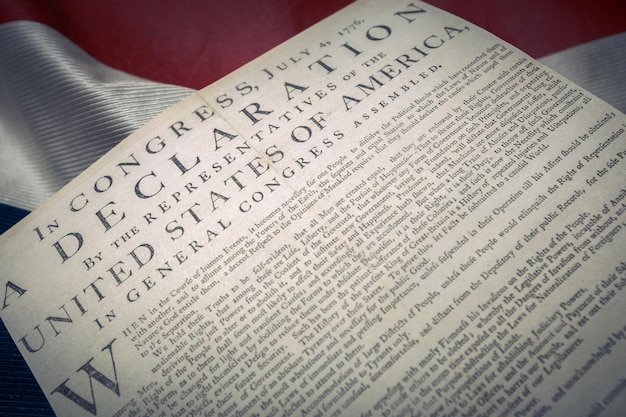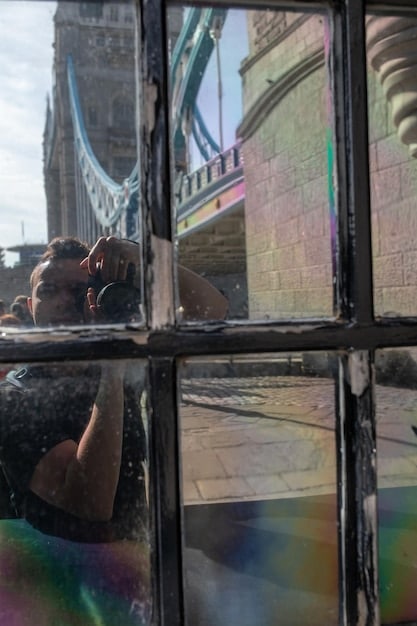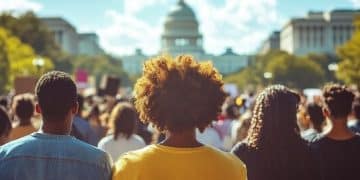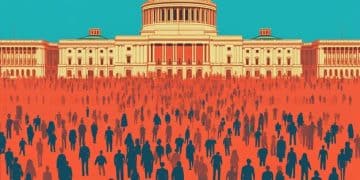Religious Freedom vs. Discrimination: Legal Gray Areas in the US

Religious freedom in the U.S. is constitutionally protected, but its intersection with anti-discrimination laws creates legal complexities and gray areas, particularly concerning LGBTQ+ rights and religious accommodations in public and private sectors.
Navigating the intricate landscape of religious freedom vs. discrimination: navigating the legal gray areas in the US requires a deep understanding of constitutional rights and the application of these rights in a diverse and evolving society. The balance between protecting religious expression and ensuring equal treatment for all is a continuous challenge.
Understanding the First Amendment and Religious Freedom
The First Amendment to the United States Constitution guarantees citizens the right to practice their religion freely, a cornerstone of American liberty. This protection, however, is not absolute and often intersects with other legal principles, leading to complex judicial interpretations.
The Establishment Clause and Free Exercise Clause
The First Amendment contains two key clauses regarding religion: the Establishment Clause and the Free Exercise Clause. The Establishment Clause prevents the government from establishing an official religion, while the Free Exercise Clause protects individuals’ rights to practice their religion without government interference.
Historical Context of Religious Freedom
Religious freedom has been a central theme in American history since the colonial era. Early settlers often sought refuge in America to escape religious persecution, shaping the nation’s commitment to religious pluralism and tolerance.

However, the interpretation and application of these clauses have evolved over time, reflecting changing social norms and legal challenges. Here are some ways the US navigates these clauses:
- Accommodation of Religious Practices: The government is often required to accommodate religious practices, such as allowing religious head coverings in the military or providing exemptions from certain laws.
- Limits on Religious Expression: The Supreme Court has ruled that religious practices are not protected if they violate criminal laws or endanger public safety.
- Balancing Rights: Courts often balance religious freedom with other constitutional rights, such as the right to free speech and the right to equal protection under the law.
The interplay between these historical and legal factors creates a dynamic environment in which religious freedom is both protected and subject to limitations, requiring careful consideration of individual rights and societal interests.
The Conflict Between Religious Freedom and Anti-Discrimination Laws
The tension between religious freedom and anti-discrimination laws is a significant area of legal and social debate in the United States. These conflicts often arise when religious beliefs clash with laws designed to protect marginalized groups from discrimination.
LGBTQ+ Rights and Religious Objections
One of the most prominent areas of conflict involves LGBTQ+ rights. Some individuals and organizations assert that their religious beliefs prevent them from providing services to LGBTQ+ individuals, leading to legal challenges under anti-discrimination laws.
Religious Accommodations in the Workplace
Another area of conflict concerns religious accommodations in the workplace. Employees may request accommodations for religious practices, such as prayer breaks or religious attire, which can sometimes conflict with employer policies.

Understanding the balance between these rights is essential. Here are some key considerations:
- The Supreme Court’s Role: The Supreme Court has played a crucial role in adjudicating these conflicts, attempting to balance religious freedom with anti-discrimination principles.
- State and Federal Laws: Both state and federal laws address religious freedom and anti-discrimination, sometimes leading to inconsistencies and legal challenges.
- Public Accommodation Laws: These laws prohibit discrimination in places of public accommodation, such as restaurants and hotels, and often come into conflict with religious objections.
This ongoing debate reflects the complexities of balancing constitutional rights and ensuring equal treatment for all members of society, requiring careful legal analysis and nuanced policy solutions.
Landmark Supreme Court Cases
Several landmark Supreme Court cases have shaped the legal understanding of the relationship between religious freedom and anti-discrimination laws. These cases provide critical insights into how the courts balance these competing interests.
Employment Division v. Smith (1990)
Employment Division v. Smith established the principle that neutral laws of general applicability do not violate the Free Exercise Clause, even if they incidentally burden religious practices. This case involved the denial of unemployment benefits to Native Americans who used peyote in religious ceremonies.
Burwell v. Hobby Lobby (2014)
Burwell v. Hobby Lobby held that closely held for-profit corporations could be exempt from regulations requiring contraception coverage in their employees’ health insurance if those regulations violated the corporations’ religious beliefs.
These cases highlight the judicial scrutiny involved in such matters. Here are some ways they interact:
- Impact on Religious Freedom: These cases have significantly impacted the scope of religious freedom protections, particularly in the context of federal laws and regulations.
- Balancing Test: The Supreme Court often employs a balancing test to weigh the government’s interests against the burden on religious exercise.
- Future Implications: The outcomes of these cases continue to shape legal debates about religious freedom and anti-discrimination, influencing legislative efforts and judicial decisions at both the state and federal levels.
By examining these landmark decisions, we can better understand the evolving legal framework governing religious freedom and its interaction with broader legal principles.
The Role of Religious Freedom Restoration Act (RFRA)
The Religious Freedom Restoration Act (RFRA) is a federal law enacted in 1993 to protect religious freedom. It was designed to prevent the government from substantially burdening a person’s exercise of religion, even if the burden results from a generally applicable rule.
RFRA’s Impact on Federal Laws
RFRA applies to federal laws and requires the government to demonstrate a compelling interest and use the least restrictive means when its actions burden religious exercise. This law has been central to numerous legal challenges involving religious freedom claims.
State-Level RFRAs
In addition to the federal RFRA, many states have enacted their own versions of the law, further extending religious freedom protections at the state level. These state RFRAs can vary in scope and application.
Here’s an explanation for the importance of RFRA in the conversation:
- Legal Challenges: RFRA has been invoked in a wide range of legal challenges, including cases involving healthcare, employment, and public accommodations.
- Controversial Applications: The law has faced criticism for its potential to be used to discriminate against LGBTQ+ individuals and other marginalized groups.
- Ongoing Debates: RFRA remains a subject of ongoing debate, with supporters arguing that it is essential to protect religious freedom and critics contending that it can undermine anti-discrimination efforts.
Understanding RFRA is crucial for comprehending the current legal landscape surrounding religious freedom and its relationship with other fundamental rights and protections.
Navigating Legal Gray Areas in Practice
Navigating the legal gray areas of religious freedom vs. discrimination: navigating the legal gray areas in the US requires careful consideration of specific scenarios and contexts. Legal principles often provide a framework, but their application can be complex and fact-dependent.
Case Studies: Real-World Examples
Examining real-world case studies can help illustrate the challenges of balancing religious freedom and anti-discrimination. These examples range from disputes over wedding services to accommodations for religious practices in the workplace.
Best Practices for Employers and Organizations
Employers and organizations can adopt best practices to navigate these issues proactively. These practices include developing inclusive policies, providing religious accommodations, and engaging in open communication with employees and stakeholders.
To better understand the nuances of implementation, consider the following:
- Inclusive Policies: Implementing inclusive policies that respect religious diversity while ensuring equal treatment for all individuals.
- Religious Accommodations: Providing reasonable accommodations for religious practices, such as prayer breaks, religious attire, and flexible scheduling.
- Conflicts Resolution: Establishing clear procedures for addressing conflicts between religious beliefs and workplace policies.
By addressing these gray areas proactively, employers and organizations can foster a more inclusive and respectful environment, minimizing the risk of legal disputes and promoting positive relationships with their employees and communities.
The Future of Religious Freedom and Anti-Discrimination Laws
The future of religious freedom and anti-discrimination laws in the United States will likely involve ongoing legal and social debates. As society evolves, new challenges and perspectives will continue to shape the interpretation and application of these laws.
Potential Legislative Changes
Legislative changes at both the state and federal levels could significantly impact the balance between religious freedom and anti-discrimination. These changes could either expand or restrict religious freedom protections, depending on the political climate and policy priorities.
The Role of Public Opinion
Public opinion will also play a critical role in shaping the future of these laws. Shifting attitudes toward religious freedom, LGBTQ+ rights, and other social issues can influence legislative and judicial decisions.
Looking ahead, we can assume:
- Evolving Interpretations: Courts will continue to grapple with the complexities of balancing religious freedom and anti-discrimination, leading to evolving interpretations of existing laws.
- New Legal Challenges: Emerging issues, such as the intersection of religious freedom and technology, will create new legal challenges and require innovative solutions.
- Collaborative Approaches: Finding common ground through dialogue and collaboration will be essential for fostering a society that values both religious freedom and equality.
By staying informed and engaged in these ongoing discussions, we can contribute to a more inclusive and equitable society that respects the rights and beliefs of all its members.
| Key Aspect | Brief Description |
|---|---|
| ⚖️ First Amendment | Guarantees religious freedom, but not absolute; intersects with Establishment and Free Exercise Clauses. |
| 🏳️🌈 LGBTQ+ Rights | Conflicts arise when religious beliefs clash with anti-discrimination laws protecting LGBTQ+ individuals. |
| 🏢 Workplace | Accommodations for religious practices can conflict with employer policies; balancing is necessary. |
| 📜 RFRA | Protects religious exercise but faces criticism for potential discrimination; impacts federal laws. |
FAQ
▼
The First Amendment guarantees freedom of religion through two clauses: the Establishment Clause, preventing government endorsement of religion, and the Free Exercise Clause, protecting individuals’ religious practices.
▼
RFRA is a federal law enacted in 1993 to protect religious freedom by preventing the government from substantially burdening a person’s exercise of religion, even if the burden results from a general rule.
▼
Anti-discrimination laws ensure equal treatment, while religious freedom protects religious practices. Conflicts arise when religious beliefs clash with protections for marginalized groups like the LGBTQ+ community.
▼
Cases like Employment Division v. Smith and Burwell v. Hobby Lobby have significantly shaped the interpretation of religious freedom, balancing government interests with individual religious rights.
▼
Employers can adopt inclusive policies, provide reasonable religious accommodations, and establish clear procedures for addressing conflicts between religious beliefs and workplace policies to foster an inclusive environment.
Conclusion
Navigating the intersection of religious freedom vs. discrimination: navigating the legal gray areas in the US requires a nuanced understanding of constitutional principles, landmark court cases, and evolving societal values. By fostering open dialogue and implementing inclusive policies, we can strive to create a society that respects both religious expression and equal rights for all individuals.





